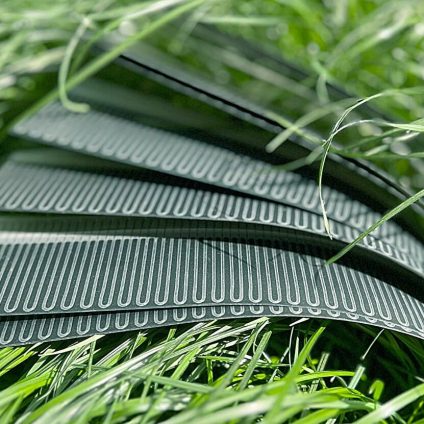Photovoltaic perovskite CIGS cells reach 24.6% efficiency and survive 3,000 bends, redefining flexible thin-film solar technology

Flexible thin-film solar cells reach new milestone. A team of researchers has developed a solar unit that achieves 24.6% efficiency while remaining flexible enough to withstand thousands of bends. Thanks to a perfectly integrated blend of semiconductors, this new photovoltaic perovskite/CIGS tandem cell maintains its performance after more than 3,000 folds, setting a benchmark in the thin-film solar market. The innovation combines a perovskite top cell with a copper indium gallium selenide (CIGS) bottom cell in a monolithic architecture.
The efficiency of perovskite/CIGS photovoltaics
This is not the first time perovskite and CIGS have been paired in a multi-junction architecture. Like all tandem approaches, the goal is to surpass the Shockley-Queisser limit of single-junction solar cells by absorbing a broader range of the solar spectrum.
The current record belongs to a team at Wuhan University, which achieved 28.4% efficiency in 2023 with a perovskite/CIGS solar cell. However, that record was set using a four-terminal tandem structure, not a monolithic one – a distinction that matters.
Monolithic vs. four-terminal tandem photovoltaics
A four-terminal tandem photovoltaic system consists of two separate sub-cells mechanically stacked and externally connected. Each sub-cell generates its own current and voltage independently.
The downside? The complexity of external wiring increases the risk of reflection and absorption losses between the layers.
By contrast, a monolithic (or two-terminal) tandem solar cell integrates the sub-cells directly on top of each other, connecting them in series. This allows each layer to absorb a specific portion of the solar spectrum, maximizing light utilization and taking advantage of potential synergistic effects between the cells to boost conversion efficiency.
The trade-off? Manufacturing is more complex. Layers must be perfectly integrated, and the currents from both sub-cells need to be precisely balanced.
This is where the work of the Chinese Academy of Sciences comes in.
The flexible and efficient perovskite/CIGS photovoltaics
Led by Professor Ye Jichun at the Ningbo Institute of Materials Technology and Engineering (NIMTE), the research team developed a high-efficiency, ultra-thin, and flexible monolithic photovoltaic perovskite CIGS cell.
The team tackled a specific challenge: improving the deposition of the perovskite layer onto the rough CIGS surface without introducing defects or compromising adhesion.
To solve this, the researchers used self-assembled monolayers (SAMs) to smooth the substrate surface, paired with a nucleation layer to support perovskite growth.
Using a solvent strategy with both high and low polarity solvents, the scientists were able to precisely control the distribution and structure of the SAMs, creating a smooth interface for the perovskite layer. Simultaneously, the pre-mixed nucleation layer improved the wettability of the CIGS surface and provided crystal growth sites for the perovskite.
Results and durability tests
The outcome was a flexible monolithic perovskite/CIGS tandem solar cell with an area of 1.09 cm² and a stabilized efficiency of 24.6%, with a certified value of 23.8% – one of the highest recorded for flexible thin-film solar cells.
After 320 hours of operation and 3,000 bending cycles at a radius of 1 cm, the device retained over 90% of its original efficiency, showcasing impressive mechanical durability and long-term stability.
The findings were published in Nature Energy under the title: Antisolvent seeding of self-assembled monolayers for flexible monolithic perovskite/Cu(In,Ga)Se₂ tandem solar cells.












